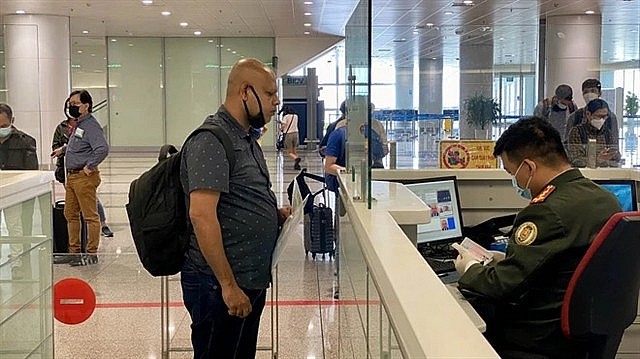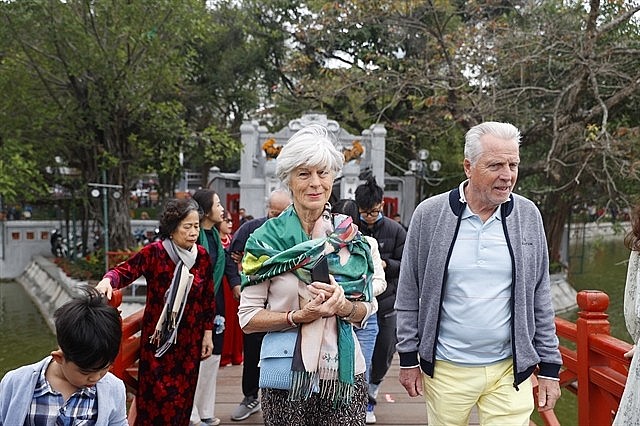 |
| Passengers at check-in counters in Noi Bai International Airport. Photo: VNA |
On February 15, Prime Minister Pham Minh Chinh issued Directive No. 06/CT-TTg, instructing the Ministry of Public Security to consider waiving visas for more countries based on the new situation and Vietnam’s relations with those countries.
Vietnam already waives visas for travelers from 25 countries, including 13 entitled to unilateral exemption. These countries are Germany, France, Italy, Spain, the UK, Russia, Japan, the Republic of Korea, Denmark, Sweden, Norway, Finland, and Belarus.
Since mid-August 2023, the country has been issuing e-visas to all foreign arrivals and extending the temporary residence period from 30 to 90 days, with unlimited entries and exits, according to Viet Nam News.
The temporary residence period for foreigners entering the country under unilateral visa exemption has been increased to 45 days.
Hoang Nhan Chinh, the head of the Secretariat of the Tourism Advisory Board (TAB), stated that reforming the visa policy is a reasonable approach and a common trend among regional countries to attract tourists after the Covid-19 pandemic.
Expanding the visa exemption policy will diversify the tourism industry’s markets, increase the number of international tourists to Vietnam, and encourage them to stay and spend more in the country, Chinh added as cited by VietnamPlus.
 |
| Foreign tourists visiting Ngoc Son Temple at Hoan Kiem Lake, Hanoi in February 2024. Photo: VNA |
In addition to the potential increase in revenue and jobs, this policy is expected to help raise the number of air passengers, facilitate international trade exchanges, and attract more foreign investors to Vietnam.
Chinh emphasized that Thailand, Malaysia, and Singapore, Vietnam’s three major competitors in Southeast Asia, are also striving to attract tourists by creating favorable conditions for tourists to enter their countries.
So far, Thailand has exempted visas for citizens from 76 countries, Malaysia from 156 countries, and Singapore from 162 countries.
Chinh mentioned that since mid-August 2023, Vietnam has adjusted its visa policy to create more favorable conditions for attracting foreign tourists.
 |
| The volume of international arrivals in Vietnam is forecasted to increase in 2024. In the photo: Golden Bridge in the central city of Da Nang. Photo: VNA |
However, applying for an e-visa to Vietnam still requires tourists to spend a lot of time providing personal information and waiting for approval.
Chinh pointed out that strict requirements and time-consuming procedures are major obstacles for foreign tourists when planning to visit a country, and having a better visa policy will make Vietnam more attractive to visitors.
He stated that widening the door to attract international tourist markets is a short-term solution, in addition to medium- and long-term solutions to internal problems of the tourism industry such as promotion, digital marketing, product diversity, destination management, and human resource development.
|
This year, about 12.6 million international tourists have visited Vietnam, a 3.4-fold increase from 2022, surpassing the target of 8 million set earlier, according to the General Statistics Office (GSO). However, this figure is equivalent to only 70% of the pre-pandemic level in 2019, the agency said. In December alone, it stood at nearly 1.4 million, up 11.2% month-on-month and 93.9% year-on-year. The volume of international arrivals in Vietnam is forecasted to increase in 2024, according to a report titled “Vietnam Travel Landscape 2024” released by The Outbox Company on January 17. The report highlights main trends such as experiential tourism, wellness tourism, eco-tourism, and sports tourism. Tourists’ increasing preference for brands that match personal values and ethics will change the market. |
Saigon among world’s fastest growing tourist cities
Ho Chi Minh City has been listed among the 15 fastest-growing tourist cities in the world by the Travelsupermarket website.








